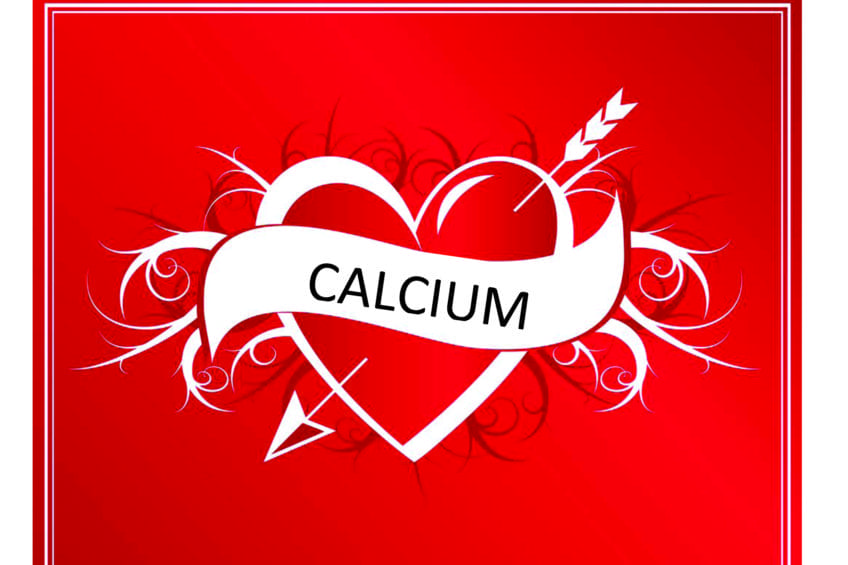Show your Heart Some Love with Calcium
When we think about heart health and diet the first nutrient that usually comes to mind is fat. Calcium is something we think about for bone health but heart health? Do we need to monitor our intake? How much should we take? Should we just take supplements?
These are questions I have been asked over the last few years so I thought I would share with our readers calcium’s role in keeping our hearts ticking along to a normal rhythm.
The heart hearts calcium
99% of the calcium in our body is utilized for building bone and teeth matrix (1). Even though the remaining 1% does not seem like a significant amount, that 1% plays a vital role in blood clotting, transmitting nerve impulses, cell metabolism and muscle contractions. Our heart depends on that little amount of calcium to beat properly and regulate our blood pressure.
Our body is very efficient at ensuring there is enough calcium circulating in our blood to carry this out. Even pulling calcium from our bones (where most of our calcium is stored) if our intake is too low.
Here are Health Canada’s recommended daily intakes:
|
Age (years) |
Daily Recommended Intake (DRI)(mg) |
| 0-10 | 1000 |
| 10-18 | 1300 |
| 19-70 | 1000 |
| ≥70 | 1200 |
Be aware of the variables that affect calcium balance- sodium, caffeine, cola, alcohol and protein. The more of these we consume, the more calcium is depleted from our body stores and excrete in our urine.
Calcium Confusion
To make things easy why not take a calcium supplement? This is where confusion lays. Calcium is a mineral and excessive consumption above the upper tolerable limit may put us at higher risk of having a heart attack. A study just published in December concludes that high calcium intake does not result in calcium being deposited in our blood vessels (atherosclerosis) increasing our risk of a heart attack. The authors do qualify their findings to say we can’t make any changes in the recommendations of how much calcium is safe until further research is done.
Some of the theories (which have yet to be proven) on how calcium supplements can cause problems with our blood vessels is when a high dose of calcium (greater than 500mg elemental calcium) is consumed at one time it may raise our blood levels of calcium too high and cause our blood to get thicker and form plaque which then attaches to the insides of our blood vessels. Over time this build up may increase our risk of having a heart attack or stroke (5,6).
My recommendation is to keep it simple by ensuring we meet our calcium needs through the food (see table below.)
Excessive intake of calcium from our diet does not seem to have the same effect. The rational is that calcium from our food is broken down and absorbed more slowly in smaller amounts spread throughout the day. As a result the calcium levels in our blood do not rapidly increase and therefore there are no negative side effects.
If you have a medical condition that impacts your absorption or increases your requirements then some extra precautions need to be considered.
| Food | Serving size | mg of calcium |
| Dairy:Cheese
Cottage cheese Milk/soy/almond Yogurt, plain |
1 oz(30g)
½ cup (125ml) 1 cup(250ml) ¾ cup(175ml) |
175mg
100mg 300mg 300mg |
| Nuts and nut butters:Sesame seeds
Sesame butter Chia seeds Flax seeds Almonds Almond butter Tahini |
2 Tbsp(30ml)
2 Tbsp(30ml) 2 Tbsp(30ml) 2 Tbsp(30ml) 2 Tbsp(30ml) 2 Tbsp(30ml) 2 Tbsp(30ml) |
175mg
300mg 138mg 70mg 50mg 90mg 130mg |
| Grains:Teff | ½ cup(125ml) | 65mg |
| Fish:Salmon, mackerel, sardines, anchovy canned with bones
Pickerel, filet Rainbow Trout, filet |
3oz(90g)
3oz(90g) 3oz(90g) |
130mg
120g 78mg |
| Meat Alternatives:EdamameTofu
Legumes |
½ cup(125ml)3oz(90g)
¾ cup(175ml) |
250mg208mg
85mg (avg) |
| Vegetables:Beet greens, cooked
Bok choy, cooked Kale, raw Okra, cooked Seaweed, kelp Spinach, frozen Turnip greens, cooked |
½ cup
½ cup ½ cup ½ cup ½ cup ½ cup ½ cup |
87mg
85mg 74mg 65mg 71mg 155mg 55mg |
*Source: The Canadian Nutrient File

